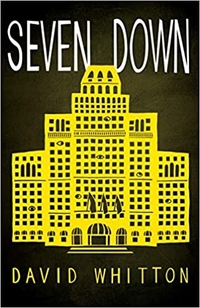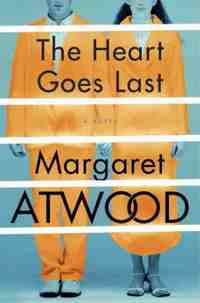Seven Down by David Whitton
 Wednesday, December 1, 2021 at 6:41AM
Wednesday, December 1, 2021 at 6:41AM 
Published by Dundurn Press/Rare Machines on November 30, 2021
In 2010, several employees of a hotel in Toronto are recruited by an organization they only know as “the company” and trained for a mission. In 2022, they finally receive the instructions to which they have been trained to respond. One of them creates a diversion in the hotel lobby, although not quite the diversion that was intended. Another retrieves a container of chutney from kitchen storage in the basement and takes it to an upper floor. A bellhop swaps clothes with a man in the elevator who takes the chutney from the woman who retrieved it. Events pile upon events. Each person narrates his or her role to interviewers/interrogators after Operation Fear and Trembling has gone awry. The story is told through their interview transcripts.
Through most of Seven Down, the reader must guess at the significance of the characters’ actions. What is the mysterious organization that recruited the hotel members? What is Operation Fear and Trembling? How and why did it fail? What were the consequences of that failure? What will happen to the participants after their interviews are finished? Some of those questions go unanswered, although the reader is given sufficient information to imagine a variety of answers. A summative document at the end supplies some missing pieces. It also makes an observation that the reader will surely appreciate: Operation Fear and Trembling was a needlessly complex means of attaining an end that could have been achieved much more easily. No wonder it went tits up.
As the reader waits for the missing pieces to be supplied, the meandering interviews reveal the personalities of the recruited employees. Leonard Downey, the bellhop who swapped clothes in the elevator, was an anarchist before he took his hotel job. At the time of the interview, he’s being held captive on an island. As one might expect from an anarchist (or maybe from anyone who is being held captive), he's far from cooperative. But he’s also quite funny as he demands cigarettes and dodges uncomfortable questions and tries to justify his decision to set a police car on fire during a G7 protest and complains that, given his experience with mayhem, the company didn’t give him a more active role than trading clothes with someone on an elevator.
Kathy from Catering, the middle-aged woman who delivered the chutney, had a sexual encounter with another character while they were both carrying out their roles, although neither knew that the other was involved in the operation. Their different perspectives on who initiated the encounter and how it went are amusing. One suspects it was initiated by the woman since she repeatedly propositions her interviewer while complaining about her lackluster sex life.
Rhonda handles security in the hotel. She epitomizes the paranoid members of society who think vaccinations will turn them into zombies. She’s convinced that heavy metals in vaccines have turned her into a walking 5G receiver. An officious and self-involved hotel manager and a systems operator who places the company ahead of her family contribute their own quirks to the dysfunctional cast of characters.
The elaborate plot of Seven Down is really just an excuse to bring together a group of troubled people who gravitate toward the company in the hope that it will supply meaning or excitement or a purpose that their lives are missing. Apart from allowing the reader to occupy the minds of its all-too-human characters, Seven Down offers some observations about humankind that are either perceptive or obvious, depending on how much attention you’re paying to the world. A character notes, for instance, that the pandemic “swept its ultraviolet wand over the earth, exposing for all to see the douchebags and sociopaths who had overrun and debased it.” A riff on “disaster capitalists” who hope to exploit the next human tragedy is also worth considering. “Plagues are the future so let’s use them to make money” is a problematic philosophy.
As a dark comedy, Seven Down delivers more chuckles than belly laughs. Still, the characters have attitude and the plot is too unpredictable to permit a reader to lose interest.
RECOMMENDED
 TChris |
TChris |  Post a Comment |
Post a Comment |  Canada,
Canada,  David Whitton in
David Whitton in  Thriller
Thriller 

